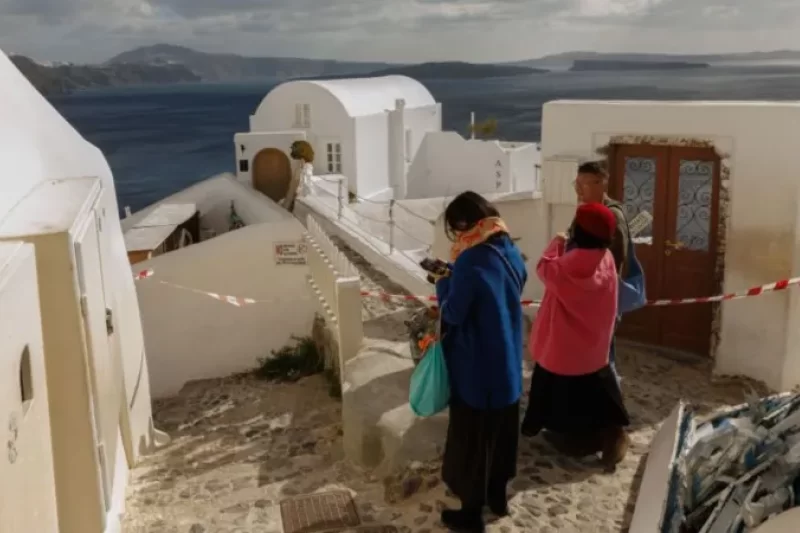State of Emergency Declared for Santorini after Quakes
A state of emergency has been declared on the Greek island of Santorini after days of consecutive earthquakes.
It comes after a magnitude 5.2 tremor was recorded at 21:09 local time (19:09 GMT) on Wednesday between the Greek islands of Amorgos and Santorini, making it the strongest in recent days. It is estimated to have occurred at a depth of 5km.
The decree will be in effect until 3 March to "address the emergency needs and manage the consequences", officials said.
More than 11,000 people have already left Santorini, with around 7,000 departing by ferry and 4,000 by air.
A 4.7 magnitude quake was also recorded south-west of Amorgos at 07:50 local time on Thursday, following 57 tremors between midnight and 06:30.
So far no major damage has been reported on the island, but authorities are taking precautionary measures and bracing in case a larger quake hits.
Greek Prime Minister Kyriakos Mitsotakis is expected to visit Santorini on Friday.
Vasilis Karastathis, director of the Geodynamic Institute, told ERTNews that "seismicity continues at the same pace as in previous days, intense."
"We have a fairly high number of earthquakes with magnitudes above 4," he said.
"Still, we are not in a position to say that we see any evidence that would lead to the sequence slowly being completed. We are still in the middle of the road. We have not seen any thinning, any sign that it is heading towards retreat."
Santorini welcomes millions of tourists annually, but it is currently low season, meaning local residents and workers make up the majority of evacuees.
Poor weather means the ferry from Santorini to Piraeus port near Athens is not operating. The adverse conditions are expected to continue over the coming days.
Many travellers remain at Santorini's port to board emergency ferry routes that have been set up as many families want to leave the island.
Schools on Santorini - and other neighbouring islands including Anafi, Paros, Naxos and Mykonos - will remain closed until Friday, when authorities will make a decision about when they can re-open.
The island has been reinforced with firefighters and medical personnel from Naxos, another island.
All hospital employees are on standby to help those who have remained on the island with all leave and days off cancelled.
Ambulance units have also arrived to reinforce the island's service and help is also expected from the armed forces.
According to the health ministry's planning, in the event of an emergency need for personnel, the first thing that will happen is doctors and nurses will come from other islands. In the event of increased need in Santorini, doctors from Athens will also be sent to the island.
A backup telecommunications station is being set up at Santorini City Hall, to be activated in the event of a major earthquake and a telecommunications problem.
Vassilis Kikilias, the climate and civil protection minister, said units of firefighters trained in natural disasters were being despatched to Santorini. Teams with special dogs and a mobile operations centre have also been sent to the island, while helicopters are on standby.
Kikilias also said the coast guard and armed forces would be available to assist vulnerable people who wish to evacuate.
Earlier on Wednesday, Greek Prime Minister Kyriakos Mitsotakis had struck an optimistic tone at a meeting of civil protection experts.
"First and foremost, the state trusts science and scientists. We have done this in other crises," the prime minister said.
"All plans have been implemented. Forces have been moved to Santorini and the other islands, so that we are ready for any eventuality," stressed Mitsotakis.
"We will continue like this with the good hope that things will get better, and the phenomenon will subside."
Mitsotakis concluded his statement with an appeal to the islanders to: "Stay calm and cooperate with the authorities".
"I understand the fear of being on Santorini, which is constantly shaking," he added, emphasising the situation was being assessed on a daily basis.
The Thira Chamber of Commerce had earlier requested a state of emergency be announced.
It called for businesses on the island be suspended and emergency support measures be taken in line with those during Covid-19.
"The consequences for the local economy are incalculable, the central markets are being weakened, and businesses are losing customers and revenue," the letter read.
"The island is being deserted, as 11,000 permanent residents had left by yesterday, which is expected to rise to 14,000 by the end of this week."
Santorini is on what is known as the Hellenic Volcanic Arc - a chain of islands created by volcanoes - but the last major eruption was in the 1950s.
Greek authorities have said the recent tremors were related to tectonic plate movements, not volcanic activity.
Scientists cannot predict the exact timing, size or location of earthquakes.
But there are areas of the world where they are more likely to occur, which helps governments prepare.
Earthquakes are the result of movement of tectonic plates in the earth's crust. Sometimes these plates lock together when they meet, which is called a plate boundary or a fault line.
Santorini and the other Greek Islands are near such a line.
(Source: BBC)













